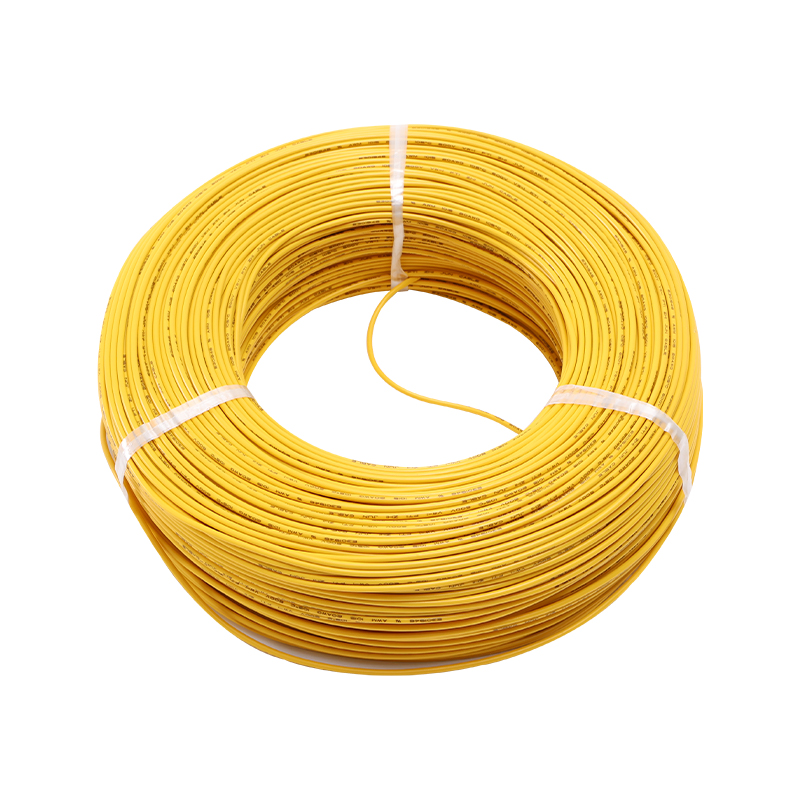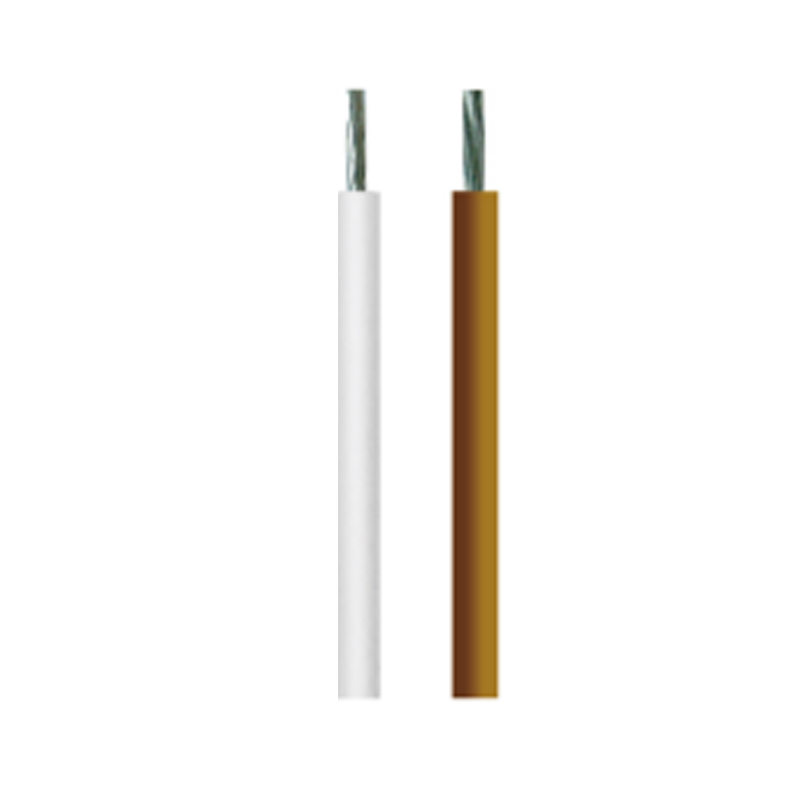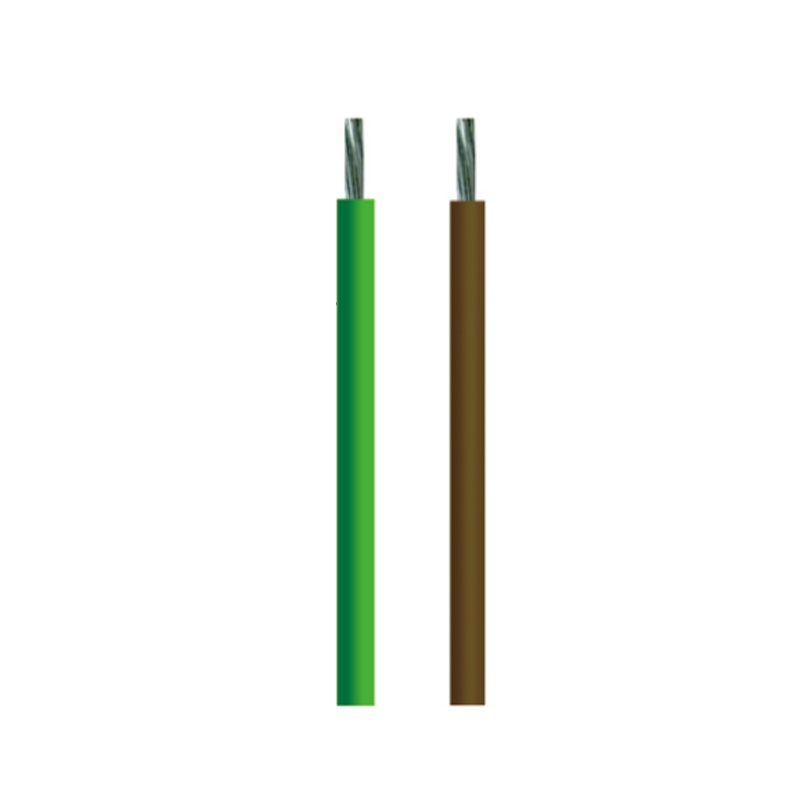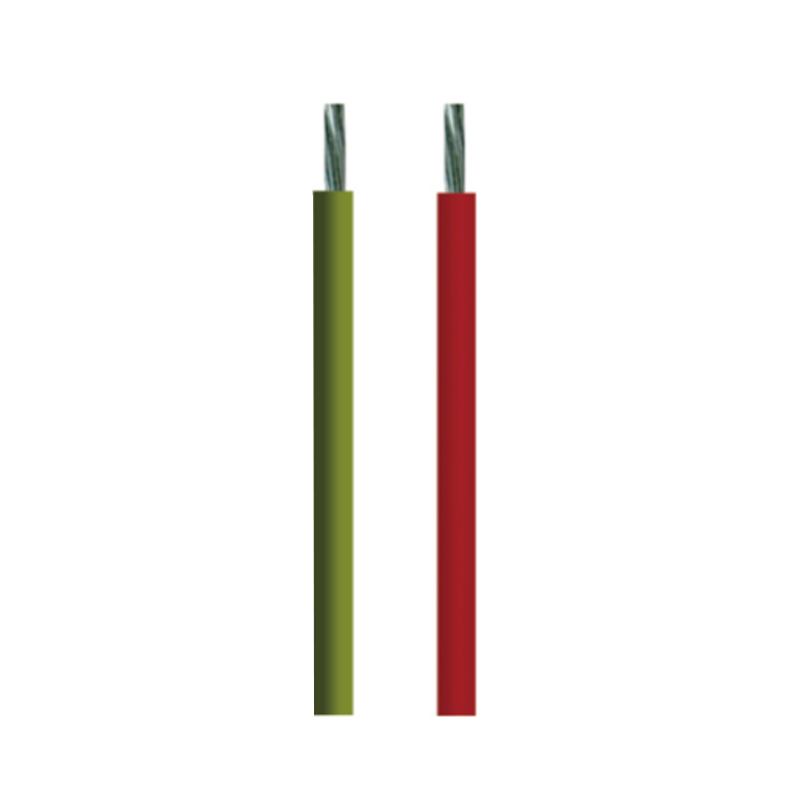1.Introduction to PTFE Insulated Wire
1.1 What is PTFE?
Polytetrafluoroethylene (PTFE) is a synthetic fluoropolymer known for its exceptional thermal stability, chemical resistance, and low surface friction. Developed in the 1930s, PTFE is widely recognized by the brand name Teflon™, though it is manufactured by multiple producers under various trademarks.
Its molecular structure, composed of carbon and fluorine atoms, results in a material that resists virtually all chemicals, maintains stability over a wide temperature range, and exhibits excellent electrical insulating properties. PTFE is non-reactive, non-stick, and hydrophobic, making it ideal for applications where durability, cleanliness, and reliability are critical.
1.2 What is PTFE Insulated Wire?
PTFE insulated wire consists of a metal conductor—typically copper, silver-plated copper, or nickel-plated copper—encased in a layer of PTFE insulation. The PTFE coating serves as a protective barrier, enabling the wire to operate reliably in demanding environments where traditional insulation materials such as PVC or rubber may fail.
This type of wire is chosen for its superior performance in extreme conditions, including high temperatures, exposure to corrosive chemicals, and applications requiring high dielectric strength. Its thermal, chemical, and electrical properties make it an essential component in industries that demand high reliability and long service life, such as aerospace, military, medical, and high-temperature industrial applications.
2.Key Properties of PTFE Insulated Wire
2.1 Temperature Resistance
PTFE insulated wire is engineered to perform across an exceptionally wide temperature range, typically from -200°C to +260°C. This makes it suitable for both cryogenic applications and high-temperature environments, such as those found in aerospace engines or industrial ovens.
Unlike many other insulation materials that degrade or melt under thermal stress, PTFE maintains its mechanical and electrical properties even when exposed to extreme heat or cold. This stability helps prevent insulation failure, short circuits, and signal loss, contributing to long-term system reliability.
2.2 Chemical Resistance
One of PTFE's most valuable characteristics is its chemical inertness. It is virtually unaffected by acids, bases, solvents, fuels, and corrosive gases. This resistance makes PTFE insulated wire ideal for use in chemically aggressive environments like refineries, chemical processing plants, and laboratories.
Even after prolonged exposure, PTFE does not swell, soften, or break down, which means the wire insulation remains intact and continues to protect the conductor beneath.
2.3 Electrical Properties
PTFE provides excellent electrical insulation. It features high dielectric strength, allowing it to resist electrical breakdown at high voltages. It also has a low dielectric constant (typically around 2.1), which minimizes signal distortion and makes it suitable for high-frequency or precision signal applications.
Additionally, PTFE's high insulation resistance ensures minimal current leakage, supporting consistent electrical performance in critical systems such as avionics or medical devices.
2.4 Mechanical Properties
Despite its high-performance thermal and chemical characteristics, PTFE insulated wire remains flexible and mechanically robust. It resists abrasion, cutting, and deformation, even in tight-bend or vibration-heavy installations.
PTFE also has one of the lowest coefficients of friction among solid materials, which reduces wear over time and eases wire installation through conduits or complex assemblies. This combination of flexibility, toughness, and longevity makes it a preferred choice where physical durability is essential.
3.Types of PTFE Insulated Wire
3.1 By Conductor Material
The performance and application range of PTFE insulated wire also depend on the type of conductor used. Common conductor materials include:
Copper: Standard bare copper offers excellent electrical conductivity and is commonly used in general-purpose applications where high flexibility and cost-effectiveness are priorities.
Silver-Plated Copper: This type enhances conductivity and oxidation resistance, especially at elevated temperatures. It’s frequently used in aerospace, military, and RF applications where signal integrity is critical.
Nickel-Plated Copper: With excellent corrosion resistance and high-temperature tolerance, nickel-plated copper conductors are ideal for use in harsh environments, particularly those involving high humidity or sustained heat exposure.
3.2 By Construction
PTFE insulated wires are available in different constructions to meet various mechanical and flexibility requirements:
Solid Core: Constructed with a single, solid strand of conductor, this type is rigid and better suited for fixed installations or where minimal movement is expected.
Stranded: Made from multiple fine wires twisted together, stranded wire is more flexible and resistant to fatigue from bending or vibration, making it suitable for dynamic or mobile applications.
3.3 By Voltage Rating
PTFE insulated wires are manufactured to support various voltage levels depending on the application’s electrical requirements:
300V: Used in signal transmission and low-power circuits, especially in instrumentation and electronic devices.
600V: Suitable for standard industrial and commercial power wiring, offering a balance of insulation strength and flexibility.
1000V: Designed for heavy-duty applications where higher voltage handling is essential, such as power distribution in military, aerospace, and industrial systems.
4.Applications of PTFE Insulated Wire
4.1 Aerospace
PTFE insulated wire is widely used in the aerospace sector due to its ability to withstand extreme temperatures, high altitudes, and chemically aggressive conditions. It is commonly found in aircraft wiring systems, avionics, and spacecraft components where reliability, weight reduction, and thermal stability are crucial. Its flame resistance and low smoke emission also support compliance with stringent aerospace safety standards.
4.2 Automotive
In advanced automotive systems—especially in high-performance and electric vehicles—PTFE insulated wire is used in engine compartments, sensor connections, and powertrain electronics. Its resistance to oil, fuel, and temperature fluctuations makes it ideal for harsh automotive environments, where failure is not an option.
4.3 Medical
Medical devices and diagnostic equipment rely on PTFE insulated wire for its cleanliness, chemical resistance, and ability to withstand sterilization processes, including autoclaving. It is used in everything from surgical instruments to imaging systems, where consistent electrical performance and safety are essential.
4.4 Military
Military applications demand rugged, reliable wiring capable of withstanding combat and extreme environmental conditions. PTFE insulated wire is used in communication systems, radar units, ground vehicles, and weapons systems, meeting strict MIL-spec standards for durability, thermal resistance, and insulation integrity.
4.5 Industrial
PTFE wire is a mainstay in industries involving high temperatures, chemical exposure, or mechanical stress. It's used in furnaces, industrial ovens, robotics, chemical processing plants, and sensors. Its non-reactive, high-durability insulation helps maintain performance and reduce maintenance in demanding industrial setups.
5.Selecting the Right PTFE Insulated Wire
5.1 Consider the Application
Choosing the appropriate PTFE insulated wire starts with understanding the specific demands of the application:
Temperature Requirements: Ensure the wire can operate reliably within the expected temperature range—whether in cryogenic conditions or high-heat zones.
Chemical Exposure: In environments involving acids, solvents, oils, or gases, PTFE’s chemical resistance offers long-term protection.
Voltage and Current Requirements: Select a wire rated for the system’s electrical load to avoid breakdown or overheating.
Flexibility Needs: Consider whether the installation requires flexibility, such as in moving machinery, or if rigidity is preferred for fixed routing.
5.2 Wire Gauge
Wire gauge determines the current-carrying capacity (ampacity) and impacts voltage drop over distance:
Ampacity: Thicker wires (lower gauge numbers) carry more current and are less prone to overheating.
Voltage Drop: Over long distances, voltage loss can affect performance. Choosing an appropriate gauge minimizes this issue.
5.3 Voltage Rating
PTFE insulated wires are available in several standard voltage ratings (e.g., 300V, 600V, 1000V). Always select a wire with a voltage rating equal to or greater than the application’s maximum operating voltage. Overspecifying can also provide an added safety margin in mission-critical systems.
5.4 Conductor Material
The conductor type affects performance and cost:
Copper: Offers excellent conductivity at a competitive price.
Silver-Plated Copper: Improves oxidation resistance and high-frequency performance.
Nickel-Plated Copper: Increases durability in high-heat or corrosive environments.
Each material has trade-offs in cost, conductivity, and environmental resistance, so the best choice depends on the installation's priorities.
5.5 Standards and Certifications
For regulated industries or mission-critical systems, it's essential to select wires that meet recognized standards:
UL (Underwriters Laboratories): Ensures safety and performance in general electrical applications.
MIL-SPEC (Military Specifications): Required for defense and aerospace systems.
RoHS / REACH Compliance: Important for environmentally regulated markets and export eligibility.
6.Benefits of Using PTFE Insulated Wire
6.1 High-Temperature Performance
One of the most significant advantages of PTFE insulated wire is its ability to maintain integrity and performance at elevated temperatures. With a continuous operating range up to +260°C, it outperforms many conventional insulation materials, making it ideal for environments where thermal stability is critical to safety and system reliability.
6.2 Chemical Resistance
PTFE insulation resists attack from virtually all chemicals, including acids, bases, solvents, fuels, and corrosive gases. This level of chemical inertness ensures long service life, even in aggressive industrial or laboratory conditions. It also helps reduce maintenance frequency and the risk of insulation failure due to chemical degradation.
6.3 Durability
PTFE offers excellent mechanical durability, including high resistance to abrasion, vibration, and wear. It does not become brittle over time or under thermal cycling, and it withstands physical stress during installation or operation. This reliability minimizes the risk of downtime caused by damaged wiring.
6.4 Signal Integrity
Thanks to its low dielectric constant and stable electrical insulation properties, PTFE helps preserve signal clarity and reduce signal loss, even at high frequencies. This makes it especially valuable in applications involving data transmission, RF systems, and precision instrumentation, where consistent electrical performance is non-negotiable.
7.Common Issues and Troubleshooting
7.1 Installation Challenges
Although PTFE insulated wire offers many performance advantages, it can present challenges during installation. The insulation is tough and slick, which can make stripping the wire more difficult than with softer materials like PVC. Using the correct stripping tools—ideally ones designed for PTFE—is essential to avoid damaging the conductor. Additionally, care must be taken when terminating or crimping, as improper techniques can cause insulation slippage or poor electrical contact.
7.2 Potential Failure Points
While PTFE is highly durable, some vulnerabilities remain under certain conditions:
Damage from Sharp Objects: Despite its abrasion resistance, cuts or nicks from sharp tools or edges during routing can compromise insulation integrity.
Overheating: Although PTFE handles high temperatures well, wires can still overheat if undersized for the current load or if bundled tightly without ventilation. Prolonged overheating can cause conductor fatigue or insulation discoloration.
7.3 Tips for Ensuring Longevity
To get the best performance and longest service life from PTFE insulated wire:
Use proper installation tools designed for PTFE insulation.
Avoid excessive bending or pulling, especially near terminations.
Protect against sharp edges with grommets or cable sleeves.
Select the correct gauge and voltage rating for your specific load conditions.
Regularly inspect wiring in mission-critical systems for signs of wear, heat damage, or insulation compromise.
PTFE insulated wire offers a combination of thermal stability, chemical resistance, mechanical durability, and electrical reliability that few other insulation materials can match. Its performance in extreme environments—whether high heat, corrosive exposure, or high-frequency electrical systems—makes it a trusted choice across aerospace, military, medical, automotive, and industrial sectors.
When selecting PTFE insulated wire, careful consideration of application-specific requirements such as temperature range, chemical exposure, voltage, current capacity, flexibility, and compliance standards ensures optimal performance and longevity. Whether you're designing a high-reliability control system or wiring for harsh industrial conditions, PTFE insulation provides the protection and durability needed to keep critical systems running.
As materials science continues to evolve, PTFE remains a benchmark for high-performance insulation. Ongoing innovations may bring enhancements in processing, environmental footprint, and customization, but the core strengths of PTFE wire—resilience, reliability, and versatility—are likely to remain indispensable.




 English
English عربى
عربى Español
Español









